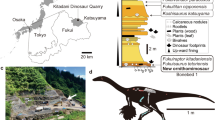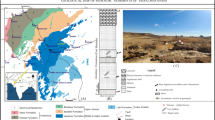Abstract
Most of what is known about the evolution of deinonychosaurs (that is, the group of theropods most closely related to birds) is based on discoveries from North America and Asia1. Except for Unenlagia comahuensis2,3 and some fragmentary remains from northern Africa4, no other evidence was available on deinonychosaurian diversity in Gondwana. Here we report a new, Late Cretaceous member of the clade, Neuquenraptor argentinus gen. et sp. nov., representing uncontroversial evidence of a deinonychosaurian theropod in the Southern Hemisphere. The new discovery demonstrates that Cretaceous theropod faunas from the southern continents shared greater similarity with those of the northern landmasses than previously thought. Available evidence suggests that deinonychosaurians were probably distributed worldwide at least by the beginning of the Cretaceous period. The phylogenetic position of the new deinonychosaur, as well as other Patagonian coelurosaurian theropods, is compatible with a vicariance model of diversification for some groups of Gondwanan and Laurasian dinosaurs.
This is a preview of subscription content, access via your institution
Access options
Subscribe to this journal
Receive 51 print issues and online access
$199.00 per year
only $3.90 per issue
Buy this article
- Purchase on Springer Link
- Instant access to full article PDF
Prices may be subject to local taxes which are calculated during checkout


Similar content being viewed by others
References
Clark, J. M., Norell, M. A. & Makovicky, P. J. in Mesozoic Birds. Above the Head of Dinosaurs (eds Chiappe, L. M. & Witmer, L.) 31–61 (Univ. California Press, Berkeley, 2002)
Novas, F. E. & Puerta, P. F. New evidence concerning avian origins from the Late Cretaceous of Patagonia. Nature 387, 390–392 (1997)
Novas, F. E. in Feathered Dragons: the Origin of Birds and Flight (eds Currie, P., Colpellhus, E. & Martin, E.) 150–166 (Indiana Univ. Press, Bloomington, 2004)
Rauhut, O. & Werner, C. First record of the family Dromaeosauridae (Dinosauria: Theropoda) in the Cretaceous of Gondwana (Wadi Milk Formation, northern Sudan). Palaont. Z. 69, 475–489 (1995)
Leanza, H., Apesteguía, S., Novas, F. E. & de la Fuente, M. S. Cretaceous terrestrial beds from the Neuquén Basin (Argentina) and their tetrapod assemblages. Cretaceous Res. 25, 61–87 (2004)
Novas, F. E. Anatomy of Patagonykus puertai (Theropoda, Maniraptora), from the Late Cretaceous of Patagonia. J. Vert. Paleontol. 17, 137–166 (1997)
Novas, F. E. Megaraptor namunhuaiquii, a large-clawed, Late Cretaceous theropod from Patagonia. J. Vert. Paleontol. 18, 4–9 (1998)
Xu, X. Deinonychosaurian Fossils from the Jehol Group of Western Lioning and the Coelurosaurian Evolution. Thesis, Chinese Academy of Sciences (2002)
Holtz, T. Jr The phylogenetic position of the Tyrannosauridae: implications for theropod systematics. J. Paleontol. 68, 1100–1117 (1994)
Xu, X., Wang, X. & Wu, X. A dromaeosaurid dinosaur with a filamentous integument from the Yixian Formation of China. Nature 401, 262–266 (1999)
Xu, X., Zhou, Z. & Wang, X. The smallest known non-avian theropod dinosaur. Nature 408, 705–708 (2000)
Hwang, S. H., Norell, M. A., Ji, Q. & Gao, K. New specimens of Microraptor zhaoianus (Theropoda: Dromaeosauridae) from Northeastern China. Am. Mus. Novit. 3381, 1–44 (2002)
Baumel, J. J. & Witmer, L. in Handbook of Avian Anatomy: Nomina Anatomica Avium Vol. 23 (eds Baumel, J. J., King, A., Breazile, J., Evans, H. & Vanden Berge, J.) 45–132 (Publications Nuttall Ornithological Club, Cambridge, 1993)
Sereno, P. C. The evolution of dinosaurs. Science 284, 2137–2147 (1999)
Xu, X., Norell, M., Wang, X.-L., Makovicky, P. J. & Wu, X. A basal troodontid from the Early Cretaceous of China. Nature 415, 780–784 (2002)
Gauthier, J. A. in The Origin of Birds and the Evolution of Flight (ed. Padian, K.) 1–55 (California Academy of Sciences, San Francisco, 1986)
Norell, M. A. & Makovicky, P. J. Important features of the dromaeosaurid skeleton II: information from newly collected specimens of Velociraptor mongoliensis . Am. Mus. Novit. 3282, 1–45 (1999)
Hwang, S. H., Norell, M. A., Ji, Q. & Gao, K. A large compsognathid from the Early Cretaceous Yixian Formation of China. J. System. Palaeontol. 2, 13–30 (2004)
Senter, P., Barsold, R., Britt, B. B. & Burnham, D. A. Systematics and evolution of Dromaeosauridae (Dinosauria, Theropoda). Bull. Gunma Mus. Nat. Hist. 8, 1–20 (2004)
Novas, F. E. & Pol, D. in Mesozoic Birds. Above the Head of Dinosaurs (eds Chiappe, L. M. & Witmer, L.) 121–125 (Univ. California Press, Berkeley, 2002)
Bonaparte, J. F. Cretaceous tetrapods of Argentina. Münchner Geowiss Abh. 30, 73–130 (1996)
Frankfurt, N. G. & Chiappe, L. M. A possible oviraptorosaur from the late Cretaceous of Northwestern Argentina. J. Vert. Paleontol. 19, 101–105 (1999)
Novas, F. E. Alvarezsauridae, Late Cretaceous maniraptorans from Patagonia and Mongolia. Queensland Mus. Mem. 39, 675–702 (1996)
Chiappe, L. M., Norell, M. A. & Clark, J. M. in Mesozoic birds. Above the Head of Dinosaurs (eds Chiappe, L. M. & Witmer, L.) 87–120 (Univ. California Press, Berkeley, 2002)
Novas, F. E. & Agnolín, F. Unquillosaurus ceibali Powell, a giant maniraptoran (Dinosauria, Theropoda) from the Late Cretaceous of Argentina. Rev. Mus. Argentino Ciencias Nat. 6, 61–66 (2004)
Novas, F. E., Canale, J. & Isasi, M. Giant deinonychosaurian theropod from the Late Cretaceous of Patagonia. J. Vert. Paleontol. 24(suppl.), 98A (2004)
Nelson, G. & Platnick, N. Systematics and Biogeography: Cladistics and Vicariance (Columbia Univ. Press, New York, 1981)
Upchurch, P., Hunn, C. A. & Norman, D. B. An analysis of dinosaurian biogeography: evidence for the existence of vicariance and dispersal patterns caused by geological events. Proc. R. Soc. Lond. B 269, 613–621 (2002)
Bonaparte, J. F. & Kielan-Jawarowska, Z. in Fourth Symposium on Mesozoic Terrestrial Ecosystems (eds Currie, P. J. & Koster, E. H.) 24–29 (Tyrrell Museum of Palaeontology Occasional Papers, Drumheller, 1987)
Xu, X. & Norell, M. A new troodontid dinosaur from China with avian-like sleeping posture. Nature 431, 838–841 (2004)
Acknowledgements
We thank X. Xing, O. Rauhut, M. Norell and P. Makovicky for comments and discussion on this subject; R. A. Coria for the loan of Neuquenraptor argentinus specimens; M. Norell for access to new specimens of Velociraptor mongoliensis; J. Ostrom and J. A. Gauthier for access to Deinonychus antirrhopus; X. Xing and P. Currie for access to several maniraptoran specimens; A. Scanferla for technical preparation of the specimen; and J. González for the illustrations. Fieldwork was supported by the National Geographic Society. This study was sponsored by Conicet, Agencia Nacional de Promoción Científica y Tecnológica, The Dinosaur Society, The Jurassic Foundation, Akapol SA, and Renault Argentina (Buenos Aires).
Author information
Authors and Affiliations
Corresponding author
Ethics declarations
Competing interests
The authors declare that they have no competing financial interests.
Supplementary information
Supplementary Data
This file gathers information about character distribution among coelurosaurian dinosaurs, phylogenetic results and cladograms supporting the hypothesis explained in the text. (DOC 46 kb)
Rights and permissions
About this article
Cite this article
Novas, F., Pol, D. New evidence on deinonychosaurian dinosaurs from the Late Cretaceous of Patagonia. Nature 433, 858–861 (2005). https://doi.org/10.1038/nature03285
Received:
Accepted:
Issue Date:
DOI: https://doi.org/10.1038/nature03285
This article is cited by
-
A fast-growing basal troodontid (Dinosauria: Theropoda) from the latest Cretaceous of Europe
Scientific Reports (2021)
-
New theropod dinosaur from the Upper Cretaceous of Patagonia sheds light on the paravian radiation in Gondwana
The Science of Nature (2020)
-
The earliest dromaeosaurid theropod from South America
Nature (2005)
-
Minute theropod eggs and embryo from the Lower Cretaceous of Thailand and the dinosaur-bird transition
Naturwissenschaften (2005)
Comments
By submitting a comment you agree to abide by our Terms and Community Guidelines. If you find something abusive or that does not comply with our terms or guidelines please flag it as inappropriate.



